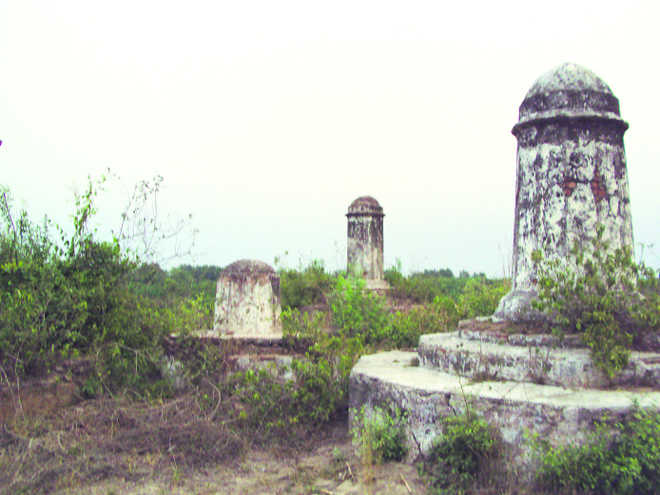Prof Mohan Maitray
Haryana, once a part of 'Sapt Sindhu Pradesh' is said to be the ‘Flag-bearer of Vedic culture’. Sages of ancient times meditated on the banks of the sacred Saraswati river and performed yajnas. Not being an abode of Har (Shiva) or Hari (Vishnu), but on account of fertility and greenery bestowed by the Saraswati, the land is known as Haryana. The sages gifted Vedas and various scriptures and the same are sources of Vedic culture.
Buddhist thought and Vedic gospel differ in many aspects. In this context, the rise of Buddhism in the domain of Vedic culture makes an interesting reading. The region came under the influence of Buddhism during the sixth century. In fact Buddhism and Jainism were a revolt against the excessive Vedic rituals and animal sacrifices in the yajnas. Later on Sikh Gurus—Guru Nanak Dev and Guru Gobind Singh—on their visit to Kurukshetra on the eve of solar eclipse, raised their voice against superstitions creeping into the ancient religion.
Haryana has a number of important pre-Harappan and Harappan civilization sites at different places. Here we also have 22 ancient Buddhist sites having the potential to be listed as protected heritage monuments. The Buddha delivered his important sermons-Mahasati Patthana Sutta, Mgandkiya Sutta, Ananjujay Sutta and Mahanidan Sutta in different parts of Haryana. The Buddha, according to Buddhist texts, visited Sugh (Yamunanagar) and the fact is endorsed by archaeological evidence. Historians claim that the Buddha along with his disciple Ananda travelled through Haryana on the Mathura-Taxila trade route and reached Gandhara.
The old mound of Sugh lies in an area of 12 km and the town was located at a height of 15 metres on the mound. According to General Cunningham, said to be the father of Indian archaeology, Sugh occupies a remarkable position in his researches. In shape it is almost triangular with a large projecting foot on citadel at each of the angles. The Chinese pilgrim, Hwen Thsang, who visited the area in the seventeenth century, mentions the village as ‘Srughana’. It has been said to be the capital of the country relating to the later part of the Hindu history. Hwen Thsang claims that Srughana (Sugh was a seat of considerable learning both Buddhist and Brahmanical. Panini, an ancient scholar, mentions three centres of higher learning in the country—Taxila, Nalanda and Sugh. Students of the Sugh centre were identified as “Sugnees”. People from abroad, even from Muslim countries, came to Sugh for study in the fields of astrology, philosophy and comparative religion.
During the rainy season pottery of the earlier times, coins relating to various kings and old idols of Lord Hanuman can be located in various corners of the mound of Sugh. Some idols have been preserved in the Museum and Art Gallery in Chandigarh. General Cunningham discovered from this place about 125 old coins—Chohan and Tunar, Rajas of Delhi and Mughal period. Broken bricks of large size 9½ to 10½ inches broad and 2½ to 3½ inches thick were also discovered. These finds may enable the researchers to reconstruct the history of the region.
Mahatma Buddha, according to researchers, also visited Aadi Badri, the rising place of the Saraswati river and close to Sugh, where Vedic Rishis had meditated. In excavation of the areas Buddha vihars and stupas have been located here. These outnumber all the remains located in other parts of Haryana. It is said that at one time 1,000 to 3,000 monks resided here. The stupas relate to the period 1500 to 1800 years earlier. A rare beautiful monastery located here presents a magnificent image of Buddha. A few cells meant for meditation are also a part of the complex. Two ancient stupas have also been located in Chaneti ( 3 km from Sugh in Yamunanagar) and Assandh (Karnal). Chaneti stupa, eight metres in height and having a diameter of 20 metres is said to be the contribution of King Ashoka. It is the oldest stupa of north India. The remains of a stupa have been found near Brahmasarovar, Kurukshetra. Agroha stupa has a rectangular base but the upper portion is domelike. Relics found at Topra are also spectacular.
The whole area around Aadi Badri needs to be projected as an ancient centre of Vedic and Buddhist culture. Kapal Mochan, Sun Temple at Amedalpur, and Aadi Badri Narain Temple, need to be developed as tourist spots. The Sun Temple here has only one other temple in the country of its stature and eminence—Konark in Odisha. The temple is unique as the first ray of the sun reaches its middle.
Haryana shares border with Rajasthan in the west and the south. It is probable that Buddhism travelled to Rajasthan from Haryana. Buddhist relics are found in Rajasthan in the form of caves, stupas, idols and stone carvings. Stone carvings in Pali and Sanskrit have been located at Berath and Koshvardhan (Sher Ghar). The carving of Darra (Kota) is in Brahmi. Idols and stups are common in Bhadar Kali, Pir Sultan Munde (Lalsot, Rajasthan). Viharas were constructed in Kolbe (Jhalabad, Rajasthan), Gunai, Hathigor and Bhinmal.
Buddhism is a fast growing religion in the world. Conservation and preservation of the heritage needs to be the top priority of the government.
(The writer is an educationist and author based at Panchkula)
Tourism potential
- The whole area around Aadi Badri needs to be projected as an ancient centre of Vedic and Buddhist culture. Kapal Mochan, Sun Temple at Amedalpur, and Aadi Badri Narain Temple need to be developed as tourist spots.
- The Sun Temple here has only one other temple in the country of its stature and eminence—Konark in Odisha.
Unlock Exclusive Insights with The Tribune Premium
Take your experience further with Premium access.
Thought-provoking Opinions, Expert Analysis, In-depth Insights and other Member Only Benefits
Already a Member? Sign In Now











